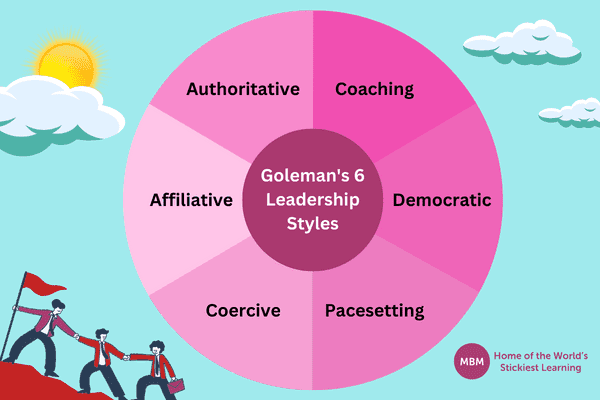Get The Emotion Right, and Work Together for a Win-Win
Goleman’s leadership styles have been helping businesspeople succeed since 2002, when Daniel Goleman, Richard Boyatzis and Annie McKee researched the leadership styles of successful executives and published their findings in their book, “Primal Leadership: Realizing the Power of Emotional Intelligence.” The styles they identified have since become known as Goleman’s 6 leadership styles.
What Are Goleman’s 6 Leadership Styles?
In summary, the 6 styles Goleman and colleagues identified in their research are as follows:
#1- Authoritative:
First of all, these people are creative, sympathetic and passionate. They have a strong vision for the big-picture future of their team or business and are focused on rallying people around it.
#2- Coaching:
This style concentrates on developing individual team members for success and collaboration in the long term. It brings out the best in people by empowering them to use their natural skills and learn new ones that help them, and therefore the team, succeed.
Sticky Learning ® is 7 times more effective than 1-day training courses. Plus, you will get a Chain of Evidence proving your Return on Investment. Discover soft skills training that changes behaviours long term.

#3- Affiliative:
An affiliative style puts people and relationships first., with a focus on creating a harmonious environment and emotional bonds. An affiliative leader has high levels of empathy and strong communication skills, allowing them to lead with motivation, care and trust.
#4- Democratic:
You have the final say, but can also count on your team’s input. They have the knowledge and experience, that’s why you employ them. The benefit for them is, you give them the flexibility to work together to reach the agreed goal.
#5- Coercive:
All in all, the leader makes all the decisions and gives orders without discussion. Close management and clearly defined roles and expectations are core elements of this style.
#6- Pacesetting:
You focus on performance and results and always seek excellence from the team. You expect the same from yourself and lead by example.

This Doesn’t Sound Like the Leadership Styles I Know
You’re right, these are different to others you may be familiar with. Back in 1939, Dr. Kurt Lewin identified three types of leadership, autocratic, democratic, and laissez-faire. In the 1930s, effective leaders were largely autocratic, especially in big businesses. Therefore, employees were dutiful and obedient.
Today’s leaders, whatever size of business, are likely to be more flexible in their thinking. They are more likely to take a situational approach. In any case, such an outlook requires self-awareness, and knowing your strengths and feelings. And it involves sensitivity to your people, as well as addressing your business needs. This is where Goleman’s styles come in.
The Research behind Goleman and Co’s book on Primal Leadership
Daniel Goleman and colleagues Annie McKee and Richard Boyatzis researched nearly 4,000 executives. They assessed these leaders’ impact on their corporate climate and bottom line. From there they identified six leadership styles, linked to emotional intelligence that motivated people and moved businesses forward. In their 2002 book ‘Primal Leadership,’ Goleman and colleagues concluded the best leaders don’t know just one leadership style they’re skilled at several, and flex style with the circumstances.


>> Leadership Coaching Cards <<
>> Access on Amazon <<
What is ‘Primal Leadership’? And How Does It Link to Goleman’s Styles?
‘Primal Leadership’ was published soon after the 9/11 attacks on the World Trade Centre shook the business world. Chiming with the era’s raised anxiety, Goleman and colleagues argued in the book that a leader’s primal task involved emotions. Hence, primal leadership’s role was to send a message that resonated with their listeners’ emotional reality and sense of purpose and moved them in a positive direction. In an uncertain climate, Goleman and colleagues said, people need leaders and managers to lend an air of certainty, not least by bringing conviction through their leadership styles, as they described in the book.
Two decades later, Goleman’s 6 leadership styles are more relevant than ever. In today’s unpredictable and fluid business environment, leaders and managers need to be change agents, skilled at navigating uncertainty and enabling teams to achieve growth. The current climate calls for them to be able to ‘flipflop’ styles as necessary for any situation, while taking their team’s feelings into account. Goleman’s 6 leadership styles enable you to do just that.
Now Let’s Get Back To The Benefits of Grasping Goleman’s Leadership Styles
Understanding Goleman’s leadership styles and being flexible brings the following benefits:
- Confirms you as a strategic leader and an asset to the organisation.
- Increases employee engagement and retention.
- Improves communication, teamwork and collaboration.
- Enhances personal and team effectiveness.
- Better equips you to develop new leaders.
Let’s Look at Goleman’s Styles in More Detail

1. Authoritative
You’re visionary, creative and charismatic. Visionaries are inspiring to work for because their positive impact delivers results, in almost any situation. And this style is particularly effective when a business is adrift. An authoritative leader charts a new course and sells their people on a long term vision.
The downside: On a bad day, you can appear autocratic, pompous or overbearing. The other thing to watch out for is that the bread-and-butter stuff of short-term activities and necessary tasks may be overlooked in favour of the grand vision to the detriment of the business.
2. Coaching
This style is highly effective. Goleman and colleagues found that some specific coaching was often all people needed in terms of time investment. That’s especially true if you know the required results and how to lead your people towards the goal. You focus on their personal development and upgrading their skills. This leadership style helps build commitment, engagement and loyalty in your team, and prepare them to become leaders themselves.
The downside: Coaching as a leadership style works well when colleagues know their limitations and are open to change. Also, it’s good if you need results quickly. But under serious pressure, this approach can seem painfully slow. And it won’t work if employees aren’t open to coaching. Or the leader’s inexperienced.
3. Democratic
People accept your decisions more readily, because they know they’ve contributed. This is the democratic aspect. Also, your people know they can influence the business.
The downside: It can be more difficult to make fast decisions when you need everyone’s input. You may not have time to consult everyone. Also, some people will do less well because they don’t like making decisions. Or they may feel they’re working harder than you. You need to put your oxygen mask on first.
As leader, you may find this way of doing things takes longer and needs more effort, so you feel burnt out. Remember, Goleman’s styles are designed to make you feel more flexible, while keeping the team onside. It may be time to step in and exert your authority.
4. Affiliative
This style places individuals’ wellbeing above company tasks and goals. You put your people first and show great empathy. You flatten the leadership hierarchy to ensure consensus in decision making, creative solutions and a sense of engagement and ownership by all members. True affiliative leadership inspires fierce loyalty because it fosters communication and flexibility, and high levels of trust result. Moreover, motivating your team like this comes naturally to some leaders, particularly in tough times.
But beware. You promote harmony and heal rifts in your team, but you may have problems improving poor performance. So to balance this, it’s important to put rules and boundaries in place to maintain structure, accountability and progress. For best results you should combine affiliative and authoritative leadership.
Goleman and colleagues concluded that these first four styles build positive cultures, with a lasting, upbeat climate. They promote harmony and effective outcomes, contributing to Co-Creation, Stephen R. Covey’s 6th Habit of Highly Effective People. Morale and job satisfaction will be high, because team members will feel that they’re making a difference.
When The Going Gets Tough, Get Going With These Two Styles
The last two of Goleman’s six leadership styles are a different story:
5. Pacesetting
You set high standards for your team. Pacesetting comes into its own when things are difficult, and can be really effective. But don’t push it too hard. People on the receiving end can find it hard and controlling. As a pacesetting leader, in your drive for results, poor communication can cause problems down the line, with people working more or harder than necessary. Morale, flexibility and responsibility can all suffer. Long term, this can lead to burnout, exhaustion, and high staff turnover.
6. Coercive
This is also known as commanding. If the business is doing badly, you need to make and follow through tough decisions. You’re the boss, no argument! You kick start change and confront problem employees. But when things calm down, you need to listen more and revert to being more democratic.
What’s So Bad About Being The Boss?

Being a pacesetter is necessary at times to move the business on. And so is being coercive. The trouble is, if you sustain them for long, these styles contribute to a negative company culture. In short, people feel stressed and fed up. Therefore, the best approach is flexibility.
As we’ve said, these last two of Goleman’s styles can create tension, and should only be used in specific situations, where you want intense effort, and need to focus on short-term objectives. They shouldn’t be used for longer than necessary, or, if you must, make sure you overlay them with the other styles we’ve talked about.
What Do You Have To Do To Master Goleman’s Styles?
To know when to choose the right style for that moment, you need to know how to “read” other people and the situation you’re in. Hence, it’s good to improve your listening skills, learn how to understand body language, and boost your emotional intelligence.
Goleman’s Six Leadership Styles – Some Famous Examples:
- Authoritative: Bill Gates, Steve Jobs.
- Affiliative: the Dalai Lama.
- Democratic: General Dwight Eisenhower, Nelson Mandela.
- Coaching: Mahatma Gandhi, Mark Zuckerberg.
- Pacesetting: James Cameron, the film director.
- Coercive/commanding: Sir Winston Churchill.
Now remember our point about flexing. These famous leaders wouldn’t have used one style all the time.
From Feelings to Financial Returns, it’s Down to Leadership Style
Goleman, McKee and Boyatzis’ book ‘Primal Leadership’ proposed that a leader’s usual style creates about 70% of their business’s emotional climate. This in turn, drives around 20%, or even 30%, of a business’s profitability. Companies devote huge resources to increasing profitability just 1%. So the implications are awesome, if leaders contribute 30 times that through their behaviour!

Want to Be Able To Flex Styles Like Goleman? Develop Your Emotional Intelligence

5 Elements You Need, To Decide Your Leadership Style
In ‘Primal Leadership,’ Goleman and colleagues identify five elements, now recognised as essential tools for emotionally intelligent leaders:
- Emotional self-awareness: Knowing what you’re feeling at any time and understanding the impact your moods have on others.
- Self-regulation: Controlling or redirecting your emotions and anticipating consequences before acting on impulse.
- Motivation: Using emotional factors to achieve goals, enjoying the learning process and persevering in the face of obstacles.
- Empathy: Sensing others’ emotions.
- Social skills: Managing relationships, inspiring others and inducing desired responses.
These qualities will help you judge the right leadership style for the moment. You should also work on these traits:
Feel The Force – Great Traits To Develop, In Yourself And Others
- Adaptability: Ability to react quickly to new and changing information.
- Optimism: Vision to see the bigger picture in a difficult situation. Getting perspective and keeping moving forward, and encouraging team members to do the same.
- Initiative: The facility and eagerness to take initiative, and help team members do the same. Being able to identify and cultivate these strengths in others.
- Conflict resolution: Providing team members with opportunities to talk and resolve issues. Airing challenges before things get worse.
- Professional development: Encouraging team members to learn and cultivate new skills. Identifying strengths and areas for improvement.
- Empathy: Not just listening to team members. Making them feel heard and understood too. Seeking to understand team members’ perspective, in order to communicate effectively.
- Trustworthiness: Not just good at keeping secrets or confidences. Creating an environment of mutual trust, where team members feel supported and comfortable.
- Self-reflection: Analysing your performance and setting regular reviewed goals. Doing this while encouraging your team to pause and reflect on themselves.
Focusing on these traits will help you understand Goleman’s six leadership styles and know when and how to use them. Furthermore, it will also help your team members develop their own leadership skills.
AND FINALLY: The Nurse Will See You Now, Mr. Goleman

Blackpool Teaching Hospitals NHS Foundation Trust in Lancashire, England have an excellent downloadable PDF with their take on how this applies in nursing. Here’s how they sum up Goleman’s six leadership Styles:
- Pacesetting: “Do it my way”
- Coercive: “Do it because I say so”
- Visionary: “Let’s remind urselves of the larger purpose”
- Affiliative: “People first, task second”
- Democratic: “Let’s work it out together”
- Coaching: “Let me help you develop”
One Last Thing to Wrap Up Goleman’s Six Leadership Styles
When you’re fully familiar with all this, why not try these six steps?
- Recognise your default leadership style.
- Identify and develop your leadership strengths.
- Work on your weaknesses.
- Ask for feedback.
- Assess your ability to delegate: identify the skills your colleagues have, which could complement yours.
- Observe your leaders’ leadership styles.
Take all this on board, and you’ll be sure to do brilliantly.
Lastly, enjoyed this article on Goleman’s six leadership styles? Well, for even more useful content on leadership, check out our ultimate guide on Leadership Skills.
Updated: September 2023 by Charles Smith




